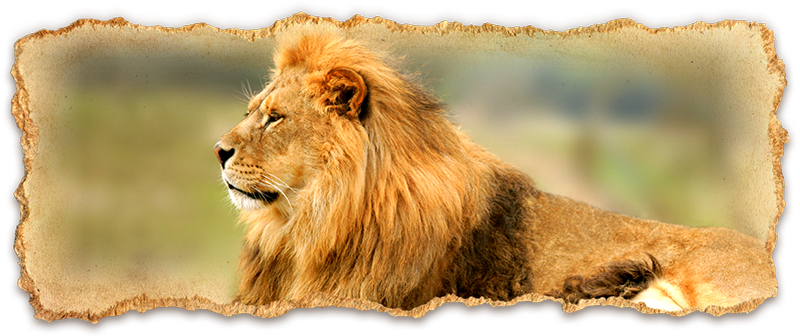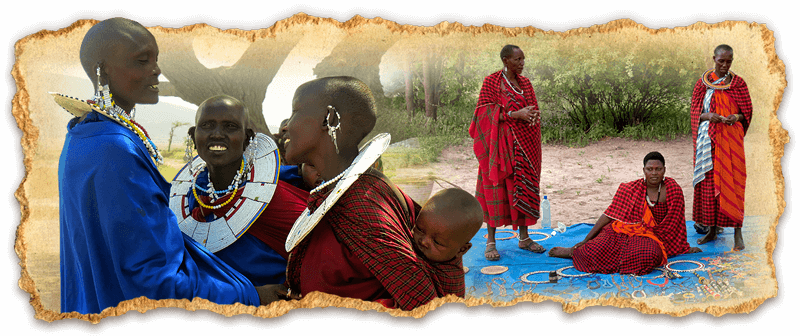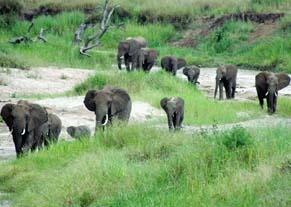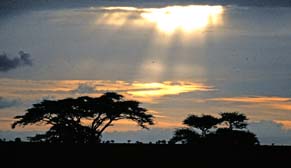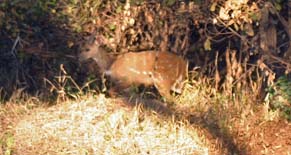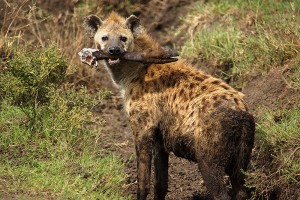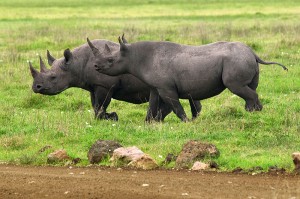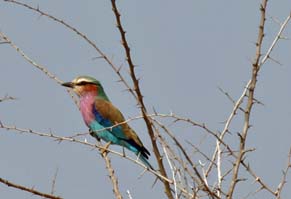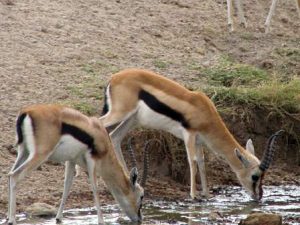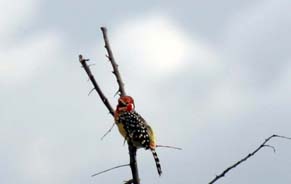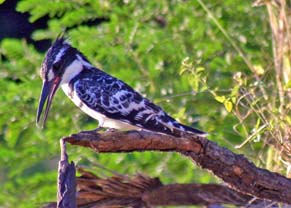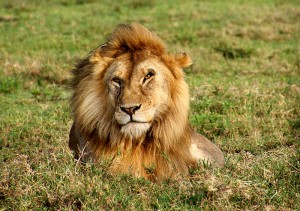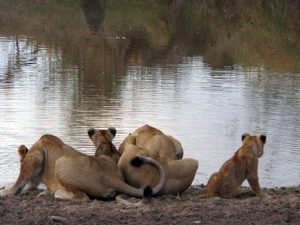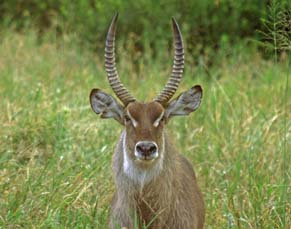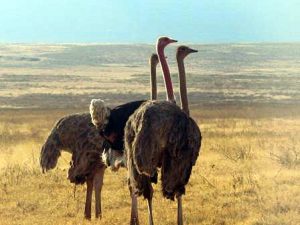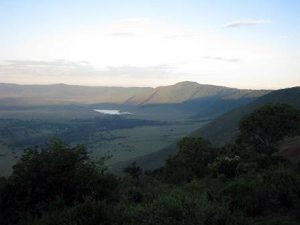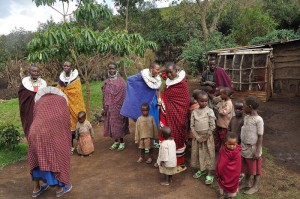Tanzania National Parks offer a lot to the adventure safari lovers, probably more than any other destination in Africa. Tanzania has set aside 40% of it’s land for fauna and flora conservation. Northern Tanzania in particular, is one of the most inspiring Safari circuits in Africa with breathtaking scenery, lush vegetation, vast and stunning Savannah with exotic wildlife diversity and abundance.
National Parks
Click on a national park in the list below to learn more.
Arusha National Park
Arusha National Park
The entrance gate leads into shadowy montane forest inhabited by inquisitive Blue monkeys and colourful turacos and trogons – the only place on the northern safari circuit where the Black-and-White Colobus Monkey is easily seen. Further north, rolling grassy hills enclose the tranquil beauty of the Momela Lakes, each one a different hue of green or blue. Their shallows sometimes tinged pink with thousands of flamingos, the lakes support a rich selection of resident and migrant water-fowl, and shaggy waterbucks display their large lyre-shaped horns on the watery fringes. Giraffes glide across the grassy hills, between grazing zebra herds, while pairs of wide-eyed dik-dik dart into scrubby bush like overgrown hares on spindly legs.
It is also at dusk and dawn that the veil of cloud on the eastern horizon is most likely to clear, revealing the majestic snow-capped peaks of Kilimanjaro, 50km (30 miles) distant.
But it is Kilimanjaro’s unassuming cousin, Mount Meru–the fifth highest in Africa at 4566 metres above sea level (14990 feet) – that dominates the park’s horizon. Its peaks and eastern footslopes protected within the national park, Meru offers unparalleled views of its famous neighbor, while also forming a rewarding hiking destination in its own right.
The entrance gate leads into shadowy montane forest inhabited by inquisitive Blue monkeys and colourful turacos and trogons – the only place on the northern safari circuit where the Black-and-White Colobus Monkey is easily seen. Further north, rolling grassy hills enclose the tranquil beauty of the Momela Lakes, each one a different hue of green or blue. Their shallows sometimes tinged pink with thousands of flamingos, the lakes support a rich selection of resident and migrant water-fowl, and shaggy waterbucks display their large lyre-shaped horns on the watery fringes. Giraffes glide across the grassy hills, between grazing zebra herds, while pairs of wide-eyed dik-dik dart into scrubby bush like overgrown hares on spindly legs.
It is also at dusk and dawn that the veil of cloud on the eastern horizon is most likely to clear, revealing the majestic snow-capped peaks of Kilimanjaro, 50km (30 miles) distant.
But it is Kilimanjaro’s unassuming cousin, Mount Meru–the fifth highest in Africa at 4566 metres above sea level (14990 feet) – that dominates the park’s horizon. Its peaks and eastern footslopes protected within the national park, Meru offers unparalleled views of its famous neighbor, while also forming a rewarding hiking destination in its own right.
- Location: 335km (208 miles) from Arusha, stretching north to Kenya and bordering Lake Victoria to the west
- What to do: Hot-air balloon safaris, game viewing. Visit neighbouring Lake Victoria and Olduvai Gorge
- Best seasons to visit:
- December–June to see the wildebeest migration
- June–October to see resident animals and predators (however, mid-March/April is the peak of the rain season)
- Learn more
Mount Meru (Arusha National Park)
Mount Meru (Arusha National Park)
Arusha National Park is a multi-faceted jewel often overlooked by Safari goers, despite offering the opportunity to explore a beguiling diversity of habitats within a few hours. Lying between the peaks of Mt. Kilimanjaro and Mt. Meru, Arusha National Park is an outstandingly beautiful area.
There are three distinct areas that are found within Arusha National Park, namely Ngurdoto Crater, the Momella Lakes and the rugged Mt. Meru. The vegetation which occurs in the Park is correlated to the altitude and geology of the area. Ngurdoto Crater is surrounded by forest, whilst the crater floor is a swampy area. The Momella Lakes (like many in the Rift Valley) are alkaline, and their shallows sometimes tinged pink with thousands of flamingos; the lakes support a rich selection of resident and migrant waterfowl.
Arusha National Park is a multi-faceted jewel often overlooked by Safari goers, despite offering the opportunity to explore a beguiling diversity of habitats within a few hours. Lying between the peaks of Mt. Kilimanjaro and Mt. Meru, Arusha National Park is an outstandingly beautiful area.
There are three distinct areas that are found within Arusha National Park, namely Ngurdoto Crater, the Momella Lakes and the rugged Mt. Meru. The vegetation which occurs in the Park is correlated to the altitude and geology of the area. Ngurdoto Crater is surrounded by forest, whilst the crater floor is a swampy area. The Momella Lakes (like many in the Rift Valley) are alkaline, and their shallows sometimes tinged pink with thousands of flamingos; the lakes support a rich selection of resident and migrant waterfowl.
Gombe Stream National Park
Gombe Stream National Park
Gombe is the smallest of Tanzania’s national parks: a fragile strip of chimpanzee habitat straddling the steep slopes and river valleys that hem in the sandy northern shore of Lake Tanganyika.
Its chimpanzees habituated to human visitors – were made famous by the pioneering work of Dr.Jane Goodall, who in 1960 founded a behavioural research program that stands as the longest-running study of its kind in the world.
The most visible of Gombe’s other mammals are also primates. A troop of beachcomber Olive baboons, under study since the 1960s, is exceptionally habituated, and stick to the forest canopy. The park’s 200 odd bird species range from the iconic African fish eagle to the jewel-like Peter’s Twinspots that hop tamely around the visitors center.
Its chimpanzees habituated to human visitors – were made famous by the pioneering work of Dr.Jane Goodall, who in 1960 founded a behavioural research program that stands as the longest-running study of its kind in the world.
The most visible of Gombe’s other mammals are also primates. A troop of beachcomber Olive baboons, under study since the 1960s, is exceptionally habituated, and stick to the forest canopy. The park’s 200 odd bird species range from the iconic African fish eagle to the jewel-like Peter’s Twinspots that hop tamely around the visitors center.
- Location: 16 km (10 miles) north of Kigoma on the shore of Lake Tanganyika in western Tanzania. Charter flight from Arusha is ideal
- What to do: Chimpanzee trekking; hiking, swimming/ snorkeling; visit the site of Henry Stanley’s famous “Dr.Livingstone I presume” at Ujiji near Kigoma, and watch the renowned builders at work
- Best time: The chimps don’t roam as far in the wet season (February-June, November-mid December) so they may be easier to find; better photo opportunities in the dry season (July-October and late December).
- Note: Strict rules are in place to safeguard you and the chimps. Allow at least 2 days to see them. This is not a zoo so there are no guarantees where they’ll be each day. [learn more]
Katavi National Park
Katavi National Park
The bulk of Katavi supports a hypnotically featureless cover of tangled brachystegia woodland, home to substantial but elusive populations of the localised eland, Sable and Roan antelopes.
But the main focus for game viewing within the park is the Katuma River and associated floodplains such as the seasonal lakes Katavi and Chada. During the rainy season, these lush, marshy lakes are a haven for myriad water birds, and they also support Tanzania’s densest concentrations of hippo and crocodile.
It is during the dry season, when the flood waters retreat, that Katavi truly comes into its own. The Katuma, reduced to a shallow, muddy trickle, forms the only source of drinking water for miles around, and the flanking floodplains support game concentrations that defy belief.
An estimated 4000 elephants might converge on the area, together with several herds of 1000-plus buffalo, while an abundance of giraffe, zebra, impala and reedbuck provide easy pickings for the numerous lion prides and spotted hyena clans whose territories converge on the floodplains.
Katavi’s most singular wildlife spectacle is provided by its hippos. Towards the end of the dry season, up to 200 individuals might flop together in any riverine pool of sufficient depth.
The bulk of Katavi supports a hypnotically featureless cover of tangled brachystegia woodland, home to substantial but elusive populations of the localised eland, Sable and Roan antelopes.
But the main focus for game viewing within the park is the Katuma River and associated floodplains such as the seasonal lakes Katavi and Chada. During the rainy season, these lush, marshy lakes are a haven for myriad water birds, and they also support Tanzania’s densest concentrations of hippo and crocodile.
It is during the dry season, when the flood waters retreat, that Katavi truly comes into its own. The Katuma, reduced to a shallow, muddy trickle, forms the only source of drinking water for miles around, and the flanking floodplains support game concentrations that defy belief.
An estimated 4000 elephants might converge on the area, together with several herds of 1000-plus buffalo, while an abundance of giraffe, zebra, impala and reedbuck provide easy pickings for the numerous lion prides and spotted hyena clans whose territories converge on the floodplains.
Katavi’s most singular wildlife spectacle is provided by its hippos. Towards the end of the dry season, up to 200 individuals might flop together in any riverine pool of sufficient depth.
- Location: Southwest Tanzania, east of lake Tanganyika. The headquarters at Sitalike lie 40km (25 miles) south of Mpanda town
- What to do: Walking, driving and camping safaris. Near lake Katavi. Visit the Tamarind Tree inhabited by the spirit of the legendary hunter Katavi (for whom the park is named). Offerings are still left here by locals seeking the spirit’s blessing
- Best time: The dry season (May-october). Roads within the park are often flooded during the rainy season but may be passable from mid December to February
- Learn more
Hiking Mount Kilimanjaro’s Lower Slopes
Hiking Mount Kilimanjaro’s Lower Slopes
Marangu Gate
Marangu Gate is the entrance to Kilimanjaro National Park, one of the most favored places to explore in Tanzania. The Marangu Route climb is considered the least arduous, yet the most popular hiking route in Africa.
Mandara Hut
From Marangu Gate, climbers ascend through a fascinating rain forest. Beyond the rain forest is a clearing that consists of a group of wooden A-framed huts—the landing at Mandara Hut. This is typically the first overnight for trekkers who wish to ascend the whole of Mt. Kilimanjaro. Relax for a bit here, as water is piped into the camp from springs above and there are flush toilets behind the main hut.
Maundi Crater
Depending on the pace of your group and weather conditions, the Marangu Route will take about 3-5 hours to the Mandara Hut checkpoint where a short hike will then take you to the Maundi Crater Rim (approx. 45 minutes). For the best views of the rim, the weather has to be clear; on clear days you’ll have magnificent views which stretch all the way to Kenya as the rim is close to the Northern border.
Marangu Gate
Marangu Gate is the entrance to Kilimanjaro National Park, one of the most favored places to explore in Tanzania. The Marangu Route climb is considered the least arduous, yet the most popular hiking route in Africa.
Mandara Hut
From Marangu Gate, climbers ascend through a fascinating rain forest. Beyond the rain forest is a clearing that consists of a group of wooden A-framed huts—the landing at Mandara Hut. This is typically the first overnight for trekkers who wish to ascend the whole of Mt. Kilimanjaro. Relax for a bit here, as water is piped into the camp from springs above and there are flush toilets behind the main hut.
Maundi Crater
Depending on the pace of your group and weather conditions, the Marangu Route will take about 3-5 hours to the Mandara Hut checkpoint where a short hike will then take you to the Maundi Crater Rim (approx. 45 minutes). For the best views of the rim, the weather has to be clear; on clear days you’ll have magnificent views which stretch all the way to Kenya as the rim is close to the Northern border.
Kitulo National Park
Kitulo National Park
Locals refer to the Kitulo Plateau as Bustani Ya Mungu -The garden of God - while botanist have dubbed it the Serengeti of flowers, host to “one of the great floral spectacles of the world." Tanzania’s newest national park is indeed a rare botanical marvel, home to a full 350 species of vascular plants. One of the most important watersheds for the Great Ruaha River, Kitulo is also the first national park in tropical Africa to be gazetted largely for its floral significance- not only a multitude of orchids, but also the stunning yellow-orange Redhot Poker and a variety of Aloes, Proteas, geraniums, giant Lobelias, lilies and Aster daisies, of which more than 30 species are endemic to southern Tanzania.
Big game is sparsely represented, but Kitulo – a botanist and hiker’s paradise – is also highly alluring to bird-watchers.
Locals refer to the Kitulo Plateau as Bustani Ya Mungu -The garden of God - while botanist have dubbed it the Serengeti of flowers, host to “one of the great floral spectacles of the world." Tanzania’s newest national park is indeed a rare botanical marvel, home to a full 350 species of vascular plants. One of the most important watersheds for the Great Ruaha River, Kitulo is also the first national park in tropical Africa to be gazetted largely for its floral significance- not only a multitude of orchids, but also the stunning yellow-orange Redhot Poker and a variety of Aloes, Proteas, geraniums, giant Lobelias, lilies and Aster daisies, of which more than 30 species are endemic to southern Tanzania.
Big game is sparsely represented, but Kitulo – a botanist and hiker’s paradise – is also highly alluring to bird-watchers.
- Location: Southern Tanzania. The temporary park headquarters at Matamba are situated approximately 100km (60 miles from Mbeya town)
- What to do: Good hiking trails exist and will soon be developed into a formal trail system. Open walking across the grasslands to watch birds and wildflowers. Hill climbing on the neighbouring ranges. A half-day hike from the park across the Livingstone Mountains leads to the sumptuous Matema Beach on Lake Nyasa
- Best time: Wildflower and orchid displays are peak between December and April. The sunnier months of September to November are more comfortable for hiking but less rewarding to botanists. Conditions are cold and foggy from June to August
- Learn more
Lake Manyara National Park
Lake Manyara National Park
The compact game –viewing circuit through Manyara offers a virtual microcosm of the Tanzanian safari experience. From the entrance gate, the road winds through an expanse of lush jungle like groundwater forest where hundred-strong baboon troops lounge nonchalantly along the roadside, Blue monkeys scamper nimbly between the ancient Mahogany trees, dainty Bushbuck tread warily through the shadows, and outsized forest hornbills honk in the high canopy.
Contrasting with the intimacy of the forest is the grassy floodplain and its expansive views eastward across the Alkakine Lake. Large buffalo, wildebeest and zebra herds congregate on these grassy plains, as do giraffes some so dark in coloration that they appear to be black from a distance.
Manyara provides the perfect introduction to Tanzania’s birdlife. More than 400 species have been recorded, and even a first-time visitor to Africa might reasonably expect to observe 100 of these in one day. Highlights include thousands of pink-hued flamingos on their perpetual migration, as well as other large waterbirds such as pelicans, cormorants and storks.
The compact game –viewing circuit through Manyara offers a virtual microcosm of the Tanzanian safari experience. From the entrance gate, the road winds through an expanse of lush jungle like groundwater forest where hundred-strong baboon troops lounge nonchalantly along the roadside, Blue monkeys scamper nimbly between the ancient Mahogany trees, dainty Bushbuck tread warily through the shadows, and outsized forest hornbills honk in the high canopy.
Contrasting with the intimacy of the forest is the grassy floodplain and its expansive views eastward across the Alkakine Lake. Large buffalo, wildebeest and zebra herds congregate on these grassy plains, as do giraffes some so dark in coloration that they appear to be black from a distance.
Manyara provides the perfect introduction to Tanzania’s birdlife. More than 400 species have been recorded, and even a first-time visitor to Africa might reasonably expect to observe 100 of these in one day. Highlights include thousands of pink-hued flamingos on their perpetual migration, as well as other large waterbirds such as pelicans, cormorants and storks.
- Location: The entrance gate lies 1.5 hours (126km/80 miles) west of Arusha along a newly surfaced road, close to the ethnically diverse market town of Mto Wa Mbu.
- What to do: Game drives and night game drives, cultural tours, mountain bike outside the park, walking safari inside the park.
- Best time: Dry season (July-October) for large mammals; wet season (November-June) for bird watching, the waterfalls and canoeing.
- Learn more
Mahale Mountains National Park
Mahale Mountains National Park
Mahale Mountains, is home to some of Africa’s last remaining wild chimpanzees: a population of roughly 800, habituated to human visitors by a Japanese research project founded in the 1960s.
The area is also known as Nkungwe, after the park’s largest mountain held sacred by the local Tongwe people, and at 2460 metres (8069 ft) the highest of the six prominent points that make up the Mahale Range. And while chimpanzees are the star attraction, the slopes support a diverse forest fauna, including readily observed troops of Colobus, Red-tailed and Blue monkeys, and a kaleidoscopic array of colorful forest birds.
The area is also known as Nkungwe, after the park’s largest mountain held sacred by the local Tongwe people, and at 2460 metres (8069 ft) the highest of the six prominent points that make up the Mahale Range. And while chimpanzees are the star attraction, the slopes support a diverse forest fauna, including readily observed troops of Colobus, Red-tailed and Blue monkeys, and a kaleidoscopic array of colorful forest birds.
- Location: 16 km (10 miles) north of Kigoma on the shore of Lake Tanganyika in western Tanzania. Charter flight from Arusha is ideal
- What to do: Chimpanzee trekking; hiking, swimming/ snorkeling; visit the site of Henry Stanley’s famous “Dr.Livingstone I presume” at Ujiji near Kigoma, and watch the renowned builders at work
- Best time: The chimps don’t roam as far in the wet season (February-June, November-mid December) so they may be easier to find; better photo opportunities in the dry season (July-October and late December).
- Learn more
Ngorongoro Crater
Ngorongoro Crater
The Ngorongoro Crater is only 3% of the total area of Ngorongoro Conservation Area (NCA), but it is home to more than 75% of all the game animals found in NCA. Technically known as a caldera, Ngorongoro crater is the largest unflooded and unbroken caldera in the world with 19.2 km in diameter, 2000 feet deep, and 102 sq miles in area. The rich pasture and permanent water of the crater floor supports a large resident population of wildlife of up to 25,000 predominantly grazing animals. These include wildebeest, zebra, buffalo, kongoni, gazelle, warthog and eland. The swamps and forest provide additional resources for hippo, elephant, waterbuck, reedbuck, and bushbuck, baboons and Vervet monkeys. The steep inner slopes provide habitat for dik-dik and the rare Mountain reedbuck.
Jackals thrive in the crater and bat-eared foxes live in the short grass area. Predatory animals such as lion, leopard, cheetah and serval cats live off the abundant wildlife; and large packs of hyenas roam the crater, making their own kills and scavenging from others. The crater is a dynamic and constantly changing ecosystem and the numbers and proportion of some animals including lions and Black rhinos have fluctuated considerably over the past 30 years. Thanks to anti-poaching patrols in the crater and the whole ecosystem, the Black rhino population is coming back. Ngorongoro crater is one of the few places in East Africa where visitors can see a rhino. [learn more]
The Ngorongoro Crater is only 3% of the total area of Ngorongoro Conservation Area (NCA), but it is home to more than 75% of all the game animals found in NCA. Technically known as a caldera, Ngorongoro crater is the largest unflooded and unbroken caldera in the world with 19.2 km in diameter, 2000 feet deep, and 102 sq miles in area. The rich pasture and permanent water of the crater floor supports a large resident population of wildlife of up to 25,000 predominantly grazing animals. These include wildebeest, zebra, buffalo, kongoni, gazelle, warthog and eland. The swamps and forest provide additional resources for hippo, elephant, waterbuck, reedbuck, and bushbuck, baboons and Vervet monkeys. The steep inner slopes provide habitat for dik-dik and the rare Mountain reedbuck.
Jackals thrive in the crater and bat-eared foxes live in the short grass area. Predatory animals such as lion, leopard, cheetah and serval cats live off the abundant wildlife; and large packs of hyenas roam the crater, making their own kills and scavenging from others. The crater is a dynamic and constantly changing ecosystem and the numbers and proportion of some animals including lions and Black rhinos have fluctuated considerably over the past 30 years. Thanks to anti-poaching patrols in the crater and the whole ecosystem, the Black rhino population is coming back. Ngorongoro crater is one of the few places in East Africa where visitors can see a rhino. [learn more]
Ngorongoro Crater (Day Trip)
Ngorongoro Crater
This caldera is an extinct volcano and the largest unbroken caldera in the world. The cone is believed to have collapsed nearly two million years ago; and while the cone was standing, it could have been as tall, if not taller, than Mount Kilimanjaro.
The Crater which is 2000 feet deep and 102 square miles, is a microcosm of African scenery with abundant wildlife including more than 25,000 larger animals. The interaction of these fauna and flora are amazing. The rest of your day will be spent here taking National Geographic photos.
The Crater will offer you outstanding opportunities to see different game animals including the rare Black rhinos, as they are protected 24-hours a day. Lake Makat on the crater floor will reward you with colourful flamingos and a variety of other birds. Patience may also reward you with glimpses of cheetah, lions, hyena, jackal, elephant, warthog, buffalo, impala, hartebeest, eland and many other antelopes. Your wildlife-viewing will be fascinating, and the experience unbeatable.
This caldera is an extinct volcano and the largest unbroken caldera in the world. The cone is believed to have collapsed nearly two million years ago; and while the cone was standing, it could have been as tall, if not taller, than Mount Kilimanjaro.
The Crater which is 2000 feet deep and 102 square miles, is a microcosm of African scenery with abundant wildlife including more than 25,000 larger animals. The interaction of these fauna and flora are amazing. The rest of your day will be spent here taking National Geographic photos.
The Crater will offer you outstanding opportunities to see different game animals including the rare Black rhinos, as they are protected 24-hours a day. Lake Makat on the crater floor will reward you with colourful flamingos and a variety of other birds. Patience may also reward you with glimpses of cheetah, lions, hyena, jackal, elephant, warthog, buffalo, impala, hartebeest, eland and many other antelopes. Your wildlife-viewing will be fascinating, and the experience unbeatable.
Mikumi National Park
Mikumi National Park
Mikumi National park abuts the northern border of Africa’s biggest game reserve – the Selous.
The open horizons and abundant wildlife of the Mkata Floodplain, the popular centre piece of Mikumi, draw frequent comparisons to the more famous Serengeti plains.
The Mkata floodplain is perhaps the most reliable place in Tanzania for sightings of the powerful eland, the world’s largest antelope. The equally impressive Greater kudu and Sable antelope haunt the Miombo covered foothills of the mountains that rise from the park’s borders. More than 400 bird species have been recorded.
Mikumi National park abuts the northern border of Africa’s biggest game reserve – the Selous.
The open horizons and abundant wildlife of the Mkata Floodplain, the popular centre piece of Mikumi, draw frequent comparisons to the more famous Serengeti plains.
The Mkata floodplain is perhaps the most reliable place in Tanzania for sightings of the powerful eland, the world’s largest antelope. The equally impressive Greater kudu and Sable antelope haunt the Miombo covered foothills of the mountains that rise from the park’s borders. More than 400 bird species have been recorded.
- Size: 3,230 sq km (1,250 sq miles), the fourth-largest park in Tanzania, and part of a much larger ecosystem centred on the uniquely vast Selous Game Reserve
- Location: 283 km (175 miles ) west of Dar Es Salaam, north of Selous, and en route to Ruaha, Udzungwa and (for the intrepid) Katavi
- What to do: Game drives and guided walks. Visit nearby Udzungwa or travel on to Selous or Ruaha
- Best time: Accessible year round
- Learn more
Ruaha National Park
Ruaha National Park
Ruaha protects a vast tract of the rugged, semi-arid bush country that characterises central Tanzania. Its lifeblood is the Great Ruaha River, where during the dry season Impala, Waterbuck and other Antelopes risk their life for a sip of life sustaining water. And the risk is considerable: not only from the prides of 20 plus Lion that lord over the Savannah, but also from the Cheetahs that stalk the open grassland and the Leopards that lurk in tangled riverine thickets. This impressive array of large predators is boosted by both Striped and Spotted Hyena, as well as several packs of the highly endangered African Wild Dog.
A similar quality is noted in the checklist of 450 birds: the likes of Crested Barbet, an attractive yellow-and- black bird whose persistent trilling is a characteristic sound of the southern bush occur in Ruaha alongside central Tanzanian endemics such as the yellow-collared Lovebird and Ashy Starling.
Ruaha protects a vast tract of the rugged, semi-arid bush country that characterises central Tanzania. Its lifeblood is the Great Ruaha River, where during the dry season Impala, Waterbuck and other Antelopes risk their life for a sip of life sustaining water. And the risk is considerable: not only from the prides of 20 plus Lion that lord over the Savannah, but also from the Cheetahs that stalk the open grassland and the Leopards that lurk in tangled riverine thickets. This impressive array of large predators is boosted by both Striped and Spotted Hyena, as well as several packs of the highly endangered African Wild Dog.
A similar quality is noted in the checklist of 450 birds: the likes of Crested Barbet, an attractive yellow-and- black bird whose persistent trilling is a characteristic sound of the southern bush occur in Ruaha alongside central Tanzanian endemics such as the yellow-collared Lovebird and Ashy Starling.
- Location: Central Tanzania, 128km (80miles) west of Iringa.
- What to do: Day walks or hiking safaris through untouched bush. Stone-age ruins at Isimila. Near Iringa, 120 km (75 miles) away, one of Africa’s most important historical sites.
- Best time: For predators and large mammals, dry season (mid-May-December); bird-watching, lush scenery and wildflowers, wet season (January-April).
- Learn more
Rubondo Island National Park
Rubondo Island National Park
Rubondo Island is tucked in the southwest corner or Lake Victoria, the world’s second-largest lake, an inland sea sprawling between Tanzania, Uganda and Kenya. With eleven smaller islands under its wing, Rubondo protects precious fish breeding grounds. Tasty tilapia form the staple diet of the Yellow-spotted otters that frolic in the island’s rocky coves, while rapacious Nile perch, some weighing more than 100kg, tempt recreational game fishermen seeking world-record catches.
Rubondo is more than a water wonderland. Deserted sandy beaches nestle against a cloak of virgin forest, where dappled Bushbuck move fleet yet silent through a maze of tamarinds, wild palms, and sycamore figs strung with a cage of trailing taproots. The shaggy-coated aquatic sitatunga, elsewhere the most elusive of antelopes, is remarkably easily observed, not only in the papyrus swamps it normally inhabits, but also in the forest interior.
Birds are everywhere. Flocks of African grey parrots-released onto the island after they were confiscated from illegal exporters – screech in comic discord as they flap furiously between the trees. The azure brilliance of a Malachite kingfisher perched low on the reeds competes with the glamorous, flowing tail of a Paradise flycatcher as it flits through the lakeshore forest. Herons, storks and spoonbills proliferate in the swampy lake fringes, supplemented by thousands of Eurasian migrants during the northern winter. Scents of wild jasmine, 40 different orchids and a smorgasbord of sweet, indefinable smells emanate from the forest.
A number of indigenous mammal species- hippo, Vervet monkey, genet and mongoose – share their protected habitat with introduced species such as chimpanzee, Black-and-white colobus, elephant and giraffe, all of which benefit from Rubondo’s inaccessibility.
Rubondo Island is tucked in the southwest corner or Lake Victoria, the world’s second-largest lake, an inland sea sprawling between Tanzania, Uganda and Kenya. With eleven smaller islands under its wing, Rubondo protects precious fish breeding grounds. Tasty tilapia form the staple diet of the Yellow-spotted otters that frolic in the island’s rocky coves, while rapacious Nile perch, some weighing more than 100kg, tempt recreational game fishermen seeking world-record catches.
Rubondo is more than a water wonderland. Deserted sandy beaches nestle against a cloak of virgin forest, where dappled Bushbuck move fleet yet silent through a maze of tamarinds, wild palms, and sycamore figs strung with a cage of trailing taproots. The shaggy-coated aquatic sitatunga, elsewhere the most elusive of antelopes, is remarkably easily observed, not only in the papyrus swamps it normally inhabits, but also in the forest interior.
Birds are everywhere. Flocks of African grey parrots-released onto the island after they were confiscated from illegal exporters – screech in comic discord as they flap furiously between the trees. The azure brilliance of a Malachite kingfisher perched low on the reeds competes with the glamorous, flowing tail of a Paradise flycatcher as it flits through the lakeshore forest. Herons, storks and spoonbills proliferate in the swampy lake fringes, supplemented by thousands of Eurasian migrants during the northern winter. Scents of wild jasmine, 40 different orchids and a smorgasbord of sweet, indefinable smells emanate from the forest.
A number of indigenous mammal species- hippo, Vervet monkey, genet and mongoose – share their protected habitat with introduced species such as chimpanzee, Black-and-white colobus, elephant and giraffe, all of which benefit from Rubondo’s inaccessibility.
- Location: Northen Tanzania, 150 km (95 miles) west of Mwanza
- Getting there: By road from Mwanza and then boat transfer. Chartered flights from Mwaanza and Arusha
- What to do: Walking safaris, boat excursions, sport fishing, chimpanzee treks, plans for canoe trips
- Best time: Dry season, June-August, is best for wildflowers and butterflies. Wet season November-March. December-February is best for migratory birds
- Learn more
Serengeti National Park
Serengeti National Park
Tanzania’s oldest and most popular national park, also a World Heritage Site and also proclaimed a Worldwide Wonder, the Serengeti is famed for its annual migration, when some two million hooves pound the open plains, as more than 200,000 zebra and 300,000 Thomson’s gazelle join the wildebeest’s trek for fresh grazing. Yet even when the migration is quiet, the Serengeti offers arguably the most scintillating game-viewing in Africa: great herds of buffalo, smaller groups of elephant and giraffes, and hundreds upon hundreds of eland, topi, kongoni, impala and Grant's gazelle.
The spectacle of predators versus prey dominates Tanzania's greatest park. Golden–mained lion prides feast on the abundance of plain grazers. Solitary leopards haunt the Acacia trees lining the Seronera River, while high densities of cheetahs prowling the southeastern plains. Almost uniquely, all three African jackal species occur here, alongside the Spotted hyena and a host of more elusive small predators, ranging from the insectivorous aardwolf to the beautiful serval cat.
But there is more to Serengeti than large mammals. 500–plus bird species, ranging from the outsized ostrich and bizarre secretary bird of the open grass-land, to the Black eagles that soar effortlessly above the Lobo Hills.
Tanzania’s oldest and most popular national park, also a World Heritage Site and also proclaimed a Worldwide Wonder, the Serengeti is famed for its annual migration, when some two million hooves pound the open plains, as more than 200,000 zebra and 300,000 Thomson’s gazelle join the wildebeest’s trek for fresh grazing. Yet even when the migration is quiet, the Serengeti offers arguably the most scintillating game-viewing in Africa: great herds of buffalo, smaller groups of elephant and giraffes, and hundreds upon hundreds of eland, topi, kongoni, impala and Grant's gazelle.
The spectacle of predators versus prey dominates Tanzania's greatest park. Golden–mained lion prides feast on the abundance of plain grazers. Solitary leopards haunt the Acacia trees lining the Seronera River, while high densities of cheetahs prowling the southeastern plains. Almost uniquely, all three African jackal species occur here, alongside the Spotted hyena and a host of more elusive small predators, ranging from the insectivorous aardwolf to the beautiful serval cat.
But there is more to Serengeti than large mammals. 500–plus bird species, ranging from the outsized ostrich and bizarre secretary bird of the open grass-land, to the Black eagles that soar effortlessly above the Lobo Hills.
- Location: 335km (208 miles) from Arusha, stretching north to Kenya and bordering Lake Victoria to the west
- What to do: Hot-air balloon safaris, game viewing. Visit neighbouring Lake Victoria, Olduvai Gorge
- Best seasons to visit:
- December–June to see the wildebeest migration
- June–October to see resident animals and predators (however, mid-March/April is the peak of the rain season)
- Learn more
Central Serengeti
Central Serengeti
Seronera region is the backbone of the central Serengeti ecosystem in terms of fauna that it accommodates during the dry season. The network of rivers and marshland ensure year-round water supplies that make life easier for the resident predators and their prey. The area is known for prides of lions, leopards and other wildlife. The rock outcrop best known as Kopjes, make the landscape even more impressive. It is not unusual to see predators such as lions and leopards perched on top of Kopjes sunbathing and enjoying the view.
Seronera region is the backbone of the central Serengeti ecosystem in terms of fauna that it accommodates during the dry season. The network of rivers and marshland ensure year-round water supplies that make life easier for the resident predators and their prey. The area is known for prides of lions, leopards and other wildlife. The rock outcrop best known as Kopjes, make the landscape even more impressive. It is not unusual to see predators such as lions and leopards perched on top of Kopjes sunbathing and enjoying the view.
Western Serengeti
Western Serengeti
Best known as Western Corridor, the western Serengeti includes River Grumeti Valley which pours its water into Lake Victoria. This region provides superb wildlife, especially the great wildebeest migration in May and June. Resident wildlife include giant crocodiles found in River Grumeti teaming up with enormous schools of hippos. Black-and-white colobus monkeys are regular resident primates that live on large trees found along River Grumeti and Mbalageti.
Best known as Western Corridor, the western Serengeti includes River Grumeti Valley which pours its water into Lake Victoria. This region provides superb wildlife, especially the great wildebeest migration in May and June. Resident wildlife include giant crocodiles found in River Grumeti teaming up with enormous schools of hippos. Black-and-white colobus monkeys are regular resident primates that live on large trees found along River Grumeti and Mbalageti.
Ndutu Plains (Southern Serengeti)
Ndutu Plains (Southern Serengeti)
Serengeti means endless plain in the Maasai language. The southern plain is where this name comes from. The vast grassy plains stretch as far as your eyes can see. It is in the southeast plain of Serengeti where the expanse herds of wildebeest migration stay from December through April. 90% of adult female wildebeest give birth in this plain during February. During this time predators such as lions, cheetahs and hyenas are seen in good numbers as their prey is in abundance.
Serengeti means endless plain in the Maasai language. The southern plain is where this name comes from. The vast grassy plains stretch as far as your eyes can see. It is in the southeast plain of Serengeti where the expanse herds of wildebeest migration stay from December through April. 90% of adult female wildebeest give birth in this plain during February. During this time predators such as lions, cheetahs and hyenas are seen in good numbers as their prey is in abundance.
Saadani National Park
Saadani National Park
Saadani is where the beach meets the bush. The only wildlife sanctuary in east Africa to boast an Indian Ocean beachfront, it possesses all the attributes that make Tanzania's tropical coastline and islands so popular with sun-worshippers. Yet it is also the one place where those idle hours of sunbathing might be interrupted by an elephant strolling past, or a lion coming to drink at the nearby waterhole!
Today a surprisingly wide range of grazers and primates is seen on game drives and walks, among them giraffe, buffalo, warthog, common waterbuck, reedbuck, hartebeest, wildebeest, Red duiker, Greater kudu, eland, Sable antelope, Yellow baboon and Vervet monkey. Herds of up to 30 elephants are encountered with increasing frequency, and several lion prides are resident along with leopard, Spotted hyena and Black-backed jackal.
Saadani is where the beach meets the bush. The only wildlife sanctuary in east Africa to boast an Indian Ocean beachfront, it possesses all the attributes that make Tanzania's tropical coastline and islands so popular with sun-worshippers. Yet it is also the one place where those idle hours of sunbathing might be interrupted by an elephant strolling past, or a lion coming to drink at the nearby waterhole!
Today a surprisingly wide range of grazers and primates is seen on game drives and walks, among them giraffe, buffalo, warthog, common waterbuck, reedbuck, hartebeest, wildebeest, Red duiker, Greater kudu, eland, Sable antelope, Yellow baboon and Vervet monkey. Herds of up to 30 elephants are encountered with increasing frequency, and several lion prides are resident along with leopard, Spotted hyena and Black-backed jackal.
- Location: On the north coast, roughly 100km (60 miles) northwest of Dar Es Salaam as the crow files and a similar distance southwest of the port of Tanga
- What to do: Game drives and guided walks. Boat trips. Visit Saadani fishing village, which lies within the reserve, where a collection of ruins pays testament to its 19th century heyday as a major trading port
- Best time: Generally accessible all-round, but the access roads are sometimes impassable during April and May. The best game-viewing is in January and February and June to August
- Learn more
Tarangire National Park
Tarangire National Park
Herds of up to 300 elephants scratch the dry river bed for underground streams, while migratory wildebeest, zebra, buffalo, impala, gazelle, hartebeest and eland crowd the shrinking lagoons. It’s the greatest concentration of wildlife outside the Serengeti ecosystem – a buffet for predators. The swamps, tinged green year round, are the focus for 550 bird varieties, the most breeding species in one habitat anywhere in the world.
Herds of up to 300 elephants scratch the dry river bed for underground streams, while migratory wildebeest, zebra, buffalo, impala, gazelle, hartebeest and eland crowd the shrinking lagoons. It’s the greatest concentration of wildlife outside the Serengeti ecosystem – a buffet for predators. The swamps, tinged green year round, are the focus for 550 bird varieties, the most breeding species in one habitat anywhere in the world.
- Location: 118 km (75 miles) southewest of Arusha
- Getting there: Easy drive from Arusha or Lake Manyara following a surfaced road to within 7km (four miles) of the main entrance gate; can continue on to Ngorongoro Crater and the Serengeti
- What to do: Guided walking safaris; day trips to Maasai and Barabaig villages, as well as to the hundreds of ancient rock paintings in the vicinity of Kolo on the Dodoma Road
- Learn more
Tarangire National Park (Day Trip)
Tarangire National Park
Tarangire National Park is the third largest national park in Tanzania. It is the vast number of Baobab trees that first capture the eye as you enter Tarangire. The gently rolling countryside is dotted with these majestic trees, which seem to dwarf the animals that feed beneath them.
The park is spectacular as it is home to herds of wildebeest, zebra, and elephant, who gather to stay in Tarangire to enjoy its abundant grazing land. Tarangire is known for its substantial herds of elephants, and an outstanding bird life. Over 300 bird species have been recorded in Tarangire. Get prepared for an interesting Safari full of great sightings.
Tarangire National Park is the third largest national park in Tanzania. It is the vast number of Baobab trees that first capture the eye as you enter Tarangire. The gently rolling countryside is dotted with these majestic trees, which seem to dwarf the animals that feed beneath them.
The park is spectacular as it is home to herds of wildebeest, zebra, and elephant, who gather to stay in Tarangire to enjoy its abundant grazing land. Tarangire is known for its substantial herds of elephants, and an outstanding bird life. Over 300 bird species have been recorded in Tarangire. Get prepared for an interesting Safari full of great sightings.
Udzungwa Mountains National Park
Udzungwa Mountains National Park
Udzungwa is the largest and most biodiverse of a chain of a dozen large forest-swathed mountains that rise majestically from the flat coastal scrub of eastern Tanzania. Known collectively as the Eastern Arc Mountains, this archipelago of isolated massifs has also been dubbed the African Galapagos for the treasure-trove of endemic plants and animals, most noteably the delicate African violet. Udzungwa alone among the ancient ranges of the Eastern Arc has been accorded national park status.
Not a conventional game viewing destination, Udzungwa is a magnet for hikers. An excellent network of forest trails includes the popular half-day ramble to Sanje Waterfall, which plunges 170 metres (550 feet) through a misty spray into the forested valley below. The more challenging two-night Mwanihana Trail leads to the high plateau, with its panoramic views over surrounding sugar plantations, before ascending to Mwanihana peak, the second-highest point in the range. Ornithologists are attracted to Udzungwa for an avian wealth embracing more than 400 species.
Udzungwa is the largest and most biodiverse of a chain of a dozen large forest-swathed mountains that rise majestically from the flat coastal scrub of eastern Tanzania. Known collectively as the Eastern Arc Mountains, this archipelago of isolated massifs has also been dubbed the African Galapagos for the treasure-trove of endemic plants and animals, most noteably the delicate African violet. Udzungwa alone among the ancient ranges of the Eastern Arc has been accorded national park status.
Not a conventional game viewing destination, Udzungwa is a magnet for hikers. An excellent network of forest trails includes the popular half-day ramble to Sanje Waterfall, which plunges 170 metres (550 feet) through a misty spray into the forested valley below. The more challenging two-night Mwanihana Trail leads to the high plateau, with its panoramic views over surrounding sugar plantations, before ascending to Mwanihana peak, the second-highest point in the range. Ornithologists are attracted to Udzungwa for an avian wealth embracing more than 400 species.
- Location: Five hours (350 km/215 miles) from Dar Es Salaam; 65 kms (40 miles) southwest of Mikumi
- Getting there: Drive from Dar es Salaam or Mikumi National Park
- What to do: Hike to the waterfall, or combine with nearby Mikumi or en route to Ruaha
- Best time: Possible year round although slippery in the rains, the dry season is June-October before the short rains but be prepared for rain any-time
- Learn more
Places of Interest
Click on a place of interest in the list below to learn more.
Walking Safari in Lake Manyara (Hiking Escape)
On Foot at Lake Manyara
Walking Safari in Lake Manyara National Park provides an opportunity to stretch and explore nature at your finger tips. The Armed Ranger who guides this walk will take you across the ground water forest which is home to varieties of wildlife including Blue monkeys, Vervet monkeys, baboons, waterbuck, and bushbucks to mention a few. Forest and woodland birds can also be seen on foot. The trail along the lake will also provide a chance to see large flocks of flamingos, herds of giraffes, cape buffaloes and impalas. This is a unique opportunity to explore nature closely outside of the vehicle.
Walking Safari in Lake Manyara National Park provides an opportunity to stretch and explore nature at your finger tips. The Armed Ranger who guides this walk will take you across the ground water forest which is home to varieties of wildlife including Blue monkeys, Vervet monkeys, baboons, waterbuck, and bushbucks to mention a few. Forest and woodland birds can also be seen on foot. The trail along the lake will also provide a chance to see large flocks of flamingos, herds of giraffes, cape buffaloes and impalas. This is a unique opportunity to explore nature closely outside of the vehicle.
Mara River Area
The Mara River
The Mara River basin covers a good size area in the Serengeti Mara Ecosystem. Mara River flows approximately 180 miles and it drains into Lake Victoria which is the largest Lake in Africa. During the end of July through the beginning of August, expanse herds of migrating wildebeest are normally heading north back to Maasai Mara Game Reserve in Kenya and one of the rivers they cross is Mara River. Thousands of guests come from all over the world to watch these movements and crossings. Around September, herds will migrate back south in Serengeti in Tanzania and cross the Mara River again. Large crocodiles take advantage of these crossings and make for themselves easy food. [learn more]
The Mara River basin covers a good size area in the Serengeti Mara Ecosystem. Mara River flows approximately 180 miles and it drains into Lake Victoria which is the largest Lake in Africa. During the end of July through the beginning of August, expanse herds of migrating wildebeest are normally heading north back to Maasai Mara Game Reserve in Kenya and one of the rivers they cross is Mara River. Thousands of guests come from all over the world to watch these movements and crossings. Around September, herds will migrate back south in Serengeti in Tanzania and cross the Mara River again. Large crocodiles take advantage of these crossings and make for themselves easy food. [learn more]
Nature Walk (adjacent Lake Manyara)
Nature Walk (adjacent Lake Manyara)
You will get an opportunity to explore on foot guided by a Maasai Guide, the expanse grassy floodplain and its expansive views eastward, adjacent the alkaline Lake Manyara. Depending on the time of the year, you may see flamingos on the lake shore. Wildebeest and zebra herds congregate on these grassy plains, as do giraffes, impalas, ostriches, warthogs and reedbucks. You will learn a lot about Maasai Medicinal plants and small creatures that can’t be seen easily on a normal game drive.
You will get an opportunity to explore on foot guided by a Maasai Guide, the expanse grassy floodplain and its expansive views eastward, adjacent the alkaline Lake Manyara. Depending on the time of the year, you may see flamingos on the lake shore. Wildebeest and zebra herds congregate on these grassy plains, as do giraffes, impalas, ostriches, warthogs and reedbucks. You will learn a lot about Maasai Medicinal plants and small creatures that can’t be seen easily on a normal game drive.
Nature Walking Highlands Forest Ngorongoro
Hiking Ngorongoro Highlands Forest
Nature walking in the Highlands Forest of Ngorongoro Conservation Area provides an opportunity to stretch and explore nature at your fingertips. The highlands forest is a vital source of water for wildlife in the Crater and the surrounding village areas. Hiking and nature walking in the pristine northern highlands forest reserve offer the opportunity to explore the nature closely outside of the vehicle. The interested attractions within the Ngorongoro pristine forest trail include the Elephant Caves and Endoro Waterfalls. [learn more]
Nature walking in the Highlands Forest of Ngorongoro Conservation Area provides an opportunity to stretch and explore nature at your fingertips. The highlands forest is a vital source of water for wildlife in the Crater and the surrounding village areas. Hiking and nature walking in the pristine northern highlands forest reserve offer the opportunity to explore the nature closely outside of the vehicle. The interested attractions within the Ngorongoro pristine forest trail include the Elephant Caves and Endoro Waterfalls. [learn more]
Olduvai Gorge Museum
Laetoli and Olduvai Gorge Museum
Laetoli is found west of Ngorongoro Crater. It is here where hominid footprints are preserved in volcanic rock 3.6 million years old and represent some of the earliest signs of mankind in the world. Excavation, mainly by the archaeologists Louis and Mary Leakey, yielded four different kinds of hominid, showing a gradual increase in brain size and in the complexity of their stone tools. The first skull of Zinjanthropus, commonly known as the "Nutcracker Man”, who lived about 1.75 million years ago was found here. [learn more]
Laetoli is found west of Ngorongoro Crater. It is here where hominid footprints are preserved in volcanic rock 3.6 million years old and represent some of the earliest signs of mankind in the world. Excavation, mainly by the archaeologists Louis and Mary Leakey, yielded four different kinds of hominid, showing a gradual increase in brain size and in the complexity of their stone tools. The first skull of Zinjanthropus, commonly known as the "Nutcracker Man”, who lived about 1.75 million years ago was found here. [learn more]
A Hike Down to the Zinj Site
A Hike Down to the Zinj Site
Oldupai Gorge is the world well known "Cradle of Mankind" where the most famous of the early human fossils Australopithecus boisei was found by Dr.Louis and Mary Leakey. It is a nearly complete cranium of an adult male; the fossil is still referred to today as "Zinj", in reference to its original name, Zinjanthropus boisei. [learn more]
Oldupai Gorge is the world well known "Cradle of Mankind" where the most famous of the early human fossils Australopithecus boisei was found by Dr.Louis and Mary Leakey. It is a nearly complete cranium of an adult male; the fossil is still referred to today as "Zinj", in reference to its original name, Zinjanthropus boisei. [learn more]
The Great Rift Valley
The Great Rift Valley
The East African Rift System (EARS) is one the geologic wonders of the world, a place where the earth's tectonic forces are presently trying to create new plates by splitting apart old ones. In simple terms, a rift can be thought of as a fracture in the earth's surface that widens over time, or more technically, as an elongate basin bounded by opposed steeply dipping normal faults. [learn more]
The East African Rift System (EARS) is one the geologic wonders of the world, a place where the earth's tectonic forces are presently trying to create new plates by splitting apart old ones. In simple terms, a rift can be thought of as a fracture in the earth's surface that widens over time, or more technically, as an elongate basin bounded by opposed steeply dipping normal faults. [learn more]
The Great Migration
The Great Migration
Each year around the same time, the circular great wildebeest migration begins in the Ngorongoro Conservation Area of the southern Serengeti in Tanzania. This migration is a natural phenomenon determined by the availability of grazing. [learn more]
Each year around the same time, the circular great wildebeest migration begins in the Ngorongoro Conservation Area of the southern Serengeti in Tanzania. This migration is a natural phenomenon determined by the availability of grazing. [learn more]
Local Culture
Click on a cultural destination in the list below to learn more.
Coffee Plantation and Garden Walk
Coffee Plantation and Garden Walk
This guided garden walk gives our travelers an opportunity to learn many facts about how coffee is grown in Tanzania, as well as visiting an organic garden to observe how different vegetables are grown here.
This guided garden walk gives our travelers an opportunity to learn many facts about how coffee is grown in Tanzania, as well as visiting an organic garden to observe how different vegetables are grown here.
Datoga People
The Datoga People
Datoga tribe are originally from Southern Sudan and Western Ethiopia. They are believed to have moved in Central Tanzania Area probably about 3000 years ago. They also live in the Arid Area near Mt.Hanang in North Central Tanzania. In Lake Eyasi basin they moved in about 150 years ago to look for better grazing land. They are semi-nomadic people mostly depending on livestock keeping, small scale farming as well as using their blacksmith skills to make a living. Maasai people call them Mang’ati which means respected Enemy. [learn more]
Datoga tribe are originally from Southern Sudan and Western Ethiopia. They are believed to have moved in Central Tanzania Area probably about 3000 years ago. They also live in the Arid Area near Mt.Hanang in North Central Tanzania. In Lake Eyasi basin they moved in about 150 years ago to look for better grazing land. They are semi-nomadic people mostly depending on livestock keeping, small scale farming as well as using their blacksmith skills to make a living. Maasai people call them Mang’ati which means respected Enemy. [learn more]
Farmers Market
Farmers Market
This is a stop where our guests can visit a local Farmers Market to see different local produce that are being sold.
This is a stop where our guests can visit a local Farmers Market to see different local produce that are being sold.
“Hunter Gatherers” Hadzabe People
The Hadzabe People
The Hadzabe people or Tindiga is the only Hunter Gatherers tribe that live in Lake Eyasi Basin adjacent Ngorongoro Conservation Area in Northern Tanzania. They are believed to be the descendant of the South Africa click speakers Bush Men. They neither grow crops nor raise livestock. Their living depends on hunting, collecting fruits and digging for roots. Their life style has not changed over the last several hundred years. [learn more]
The Hadzabe people or Tindiga is the only Hunter Gatherers tribe that live in Lake Eyasi Basin adjacent Ngorongoro Conservation Area in Northern Tanzania. They are believed to be the descendant of the South Africa click speakers Bush Men. They neither grow crops nor raise livestock. Their living depends on hunting, collecting fruits and digging for roots. Their life style has not changed over the last several hundred years. [learn more]
Iraqw Tribe
Iraqw Tribe
Originally the Iraqw Tribe immigrated from Ethiopia and are locally known for their farming and small-scale pastoralism. They are a community that dwells just outside Ngorongoro Conservation Area. [learn more]
Lake Victoria
Lake Victoria
Lake Victoria is the largest lake in Africa and the second largest freshwater lake in the world. It is a spectacular place for our guests to experience a local fishing village as well as enjoy an hour of canoeing. [learn more]
Lake Victoria is the largest lake in Africa and the second largest freshwater lake in the world. It is a spectacular place for our guests to experience a local fishing village as well as enjoy an hour of canoeing. [learn more]
Maasai Village
Maasai Village
The traditional Maasai Village is called a Manyata. This is where different Maasai families live with their livestock. The Livestock live in the middle of thick Acacia thorny fences that protect them from any possible predator attacks. The visit to these villages give guests an opportunity to learn the lifestyle of Maasai people including their culture and tradition. [learn more]
The traditional Maasai Village is called a Manyata. This is where different Maasai families live with their livestock. The Livestock live in the middle of thick Acacia thorny fences that protect them from any possible predator attacks. The visit to these villages give guests an opportunity to learn the lifestyle of Maasai people including their culture and tradition. [learn more]
Makonde Tribe
The Makonde Tribe
The Makonde tribe originally migrated north from Mozambique to the southern part of Tanzania. Located on the Makonde Plateau, they have traditionally been somewhat isolated and thus remained largely unaffected by colonial and postcolonial development. The Makonde have a reputation for cultural conservatism and a desire to defend both their territory and their way of life. They represent a strong figurative art through their authentic carvings that represent life, love and working together. Their best carving work is made out of the Ebony tree. The Makonde people along with Kamba people of Kenya are the only two tribes in East Africa that have the carving skill. [learn more]
The Makonde tribe originally migrated north from Mozambique to the southern part of Tanzania. Located on the Makonde Plateau, they have traditionally been somewhat isolated and thus remained largely unaffected by colonial and postcolonial development. The Makonde have a reputation for cultural conservatism and a desire to defend both their territory and their way of life. They represent a strong figurative art through their authentic carvings that represent life, love and working together. Their best carving work is made out of the Ebony tree. The Makonde people along with Kamba people of Kenya are the only two tribes in East Africa that have the carving skill. [learn more]
Village Walk
Village Walk
The village walk enables travelers to experience some local culture, people life and their respective activities. This may include visiting a School, Hospital, local Brick Making Centre, a Church, and more.
The village walk enables travelers to experience some local culture, people life and their respective activities. This may include visiting a School, Hospital, local Brick Making Centre, a Church, and more.


